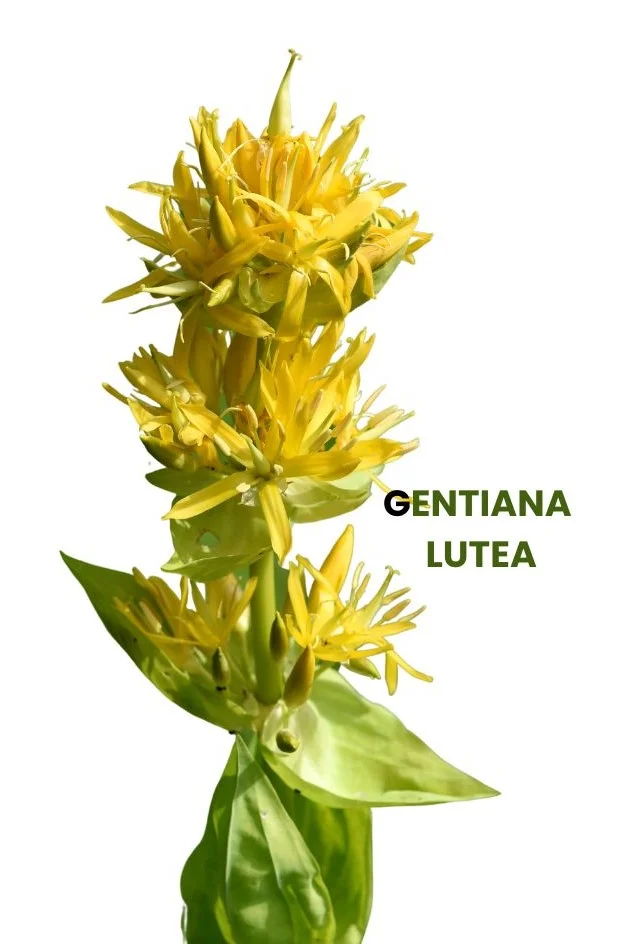Gentiana lutea, commonly known as Yellow Gentian, is a botanical remedy with a long history of medicinal use.
It is primarily recognized for its beneficial effects on the stomach, acting as a tonic and stimulating appetite.
This herbaceous plant belongs to the Gentianaceae family and is native to Europe and parts of Asia.
In homeopathy, Gentiana lutea is prepared as a remedy to address various symptoms associated with stomach disorders, digestive disturbances, and headaches.

Table of Contents
ToggleSOURCE INFORMATION
Scientific Classification
- Kingdom: Plantae
- Family: Gentianaceae
- Genus: Gentiana
- Species: Gentiana lutea
Origin
Geographical Source: Native to Europe and parts of Asia, Gentiana lutea thrives in mountainous regions with well-drained soil and ample sunlight.
Historical Facts
- Throughout history, Gentiana lutea has been valued for its medicinal properties.
- It has a long tradition of use in European herbal medicine, where it was employed to treat various digestive disorders and stimulate appetite.
DRUG PATHOGENESIS
- Stomach Symptoms: Gentiana lutea is renowned for its marked effects on stomach function. It acts as a tonic, enhancing appetite and promoting digestion.
- Headaches: Individuals experiencing headaches, particularly frontal headaches, may find relief with Gentiana lutea.
- Headaches worsened by motion and improved by eating and exposure to fresh air are common indications for this remedy.
- Throat and Mouth: Dryness of the throat and thick saliva may be present, indicating a potential use for throat-related complaints.
- Abdominal Symptoms: Symptoms such as acid risings, ravenous hunger, nausea, and abdominal discomfort, especially in the umbilical region, suggest the use of Gentiana lutea.
KEY CHARACTERISTICS
- Tonic Properties: Gentiana lutea acts as a tonic, invigorating the digestive system and increasing appetite.
- Specificity for Stomach: It is particularly useful for addressing stomach-related symptoms, including acid risings, nausea, and abdominal discomfort.
- Headache Relief: Frontal headaches worsened by motion and improved by eating and fresh air are characteristic symptoms indicating the need for Gentiana lutea.
MODALITIES
- Headaches: Worsened by rising or motion, better in open air and after eating.
- Throat: Dryness worsened by lack of moisture.
- Stomach: Symptoms aggravated by overeating or consuming heavy, indigestible food.
WHAT ARE MODALITIES IN HOMOEOPATHY?
RELATIONSHIP WITH OTHER DRUGS
Gentiana quinque flora
Indications
Intermittent fever, Dyspepsia, Cholera infantum, Weakness.
Gentiana cruciata
Indications
Throat symptoms in addition to similar stomach symptoms, Dysphagia, Vertigo with headache, Pressing inward sensation in eyes, Constricted throat, head, and abdomen, Abdominal distention, fullness, and tightness, Creeping sensation over the body, resembling flea bites.
Hydrastis
Indications
Similar stomach symptoms, Throat and mouth affections, Gastrointestinal disturbances, Digestive weakness, Weakness with debility, Chronic catarrhal conditions.
Nux Vomica
Indications
Digestive disturbances, Gastric troubles, Dyspepsia, Headaches, Irritability, Oversensitivity to external impressions.
Comparison
- Gentiana quinque flora and Gentiana cruciata share some indications with Gentiana lutea, particularly concerning stomach symptoms and weakness.
- However, each remedy may have its own distinct characteristics and specific indications based on individual symptoms.
- Hydrastis is another remedy with similarities in stomach symptoms and digestive disturbances.
- It is also useful for throat and mouth affections, making it a potential alternative or complementary remedy to Gentiana lutea.
- Nux is indicated for digestive disturbances, headaches, and irritability, but it may exhibit a different temperament and response to external stimuli compared to Gentiana lutea.
DOSE
- Potency: First to third attenuation.
Frequently Asked Questions
What is Gentiana lutea used for?
- Gentiana lutea is primarily used to address stomach symptoms, including acid risings, nausea, and increased appetite.
- It also offers relief from headaches worsened by motion and improved by eating and fresh air.
Can Gentiana lutea be used for throat-related complaints?
- Yes, Gentiana lutea may be indicated for throat dryness and thick saliva, especially when accompanied by stomach symptoms.
What is the recommended dose of Gentiana lutea?
- Gentiana lutea is typically prescribed in the first to third attenuation, according to individual symptoms and response to treatment.
Glossary of Difficult Words
- Tonic: Something that invigorates or strengthens.
- Indication: A sign or symptom suggesting the use of a particular remedy.
- Throat: The passage that leads from the back of the mouth to the stomach and lungs.
- Nausea: A sensation of discomfort in the stomach, often leading to the urge to vomit.
- Flatulence: Excessive gas in the digestive tract causing bloating and discomfort.
